Complete Solutions to Level -V of chapter THERMODYNAMICS of Class 11 book with complete answers and questions
| Class 11 | CHEMISTRY |
| Chapter | THERMODYNAMICS |
| NARAYANA | Level -V |
| Number Of Questions | 100 |
| Academic Year | 2023-24 |
Identify the correct statement for change of Gibb's energy for a system `(Delta G_("system"))` at constant temeprature and pressure:
View SolutionOne mole of an ideal gas (`C_(V) = 20 JK^(-1) mol^(-1))` initially at STP is heated at constant volume to twice the initial temeprature. For the process W and q will be
View SolutionCalculate Q and w for the isothermal reversible expansion of one mole an ideal gas from an initial pressure of 1.0 bar to a final pressure of 0.1 bar at a constant temperature of 273 K respectively.
View SolutionWhen 1 mole of gas is heated at constant volume. Temperature is raised from `298` to `308K` . Heat supplied to the gas is `500J` . Then which stamenet is correct?
View SolutionA heating coil is immersed in a 100 g sample `H_(2)O(l)` at 1 bar `100^(@)C` in a closed vessel. In this heating process, `60%` of the liquid is concerted in to gaseous form at constant pressure of 1 bar. Densities of liquid and gaseous water under these conditions are `1000kg//m^(3)` and `0.60kg//m^(3)` respectively. Magnitude of the work done for the process is :
View SolutionWhat is the value of change in internal energy at 1 atm in the process?
`H_(2)O(l,323K)rarrH_(2)O(g,423K)`
Given : `C_(v,m)(H_(2)O,l)=75.0JK^(-1) mol^(-1):" "C_(p,m)(H_(2)O,g)=33.314JK^(-1)mol^(-1)`
`DeltaH_(vap)"ar 373 K"=40.7KJ//mol`
View SolutionThe standard enthalpy of formation of octane `(C_(8)H_(18))` is `-250kJ //mol`. Calculate the enthalpy of combustion of `C_(8)H_(18)`. The enthalpy of formation of `CO_(2)(g)` and `H_(2)O(l)` are `-394 kJ//mol` and `-286kJ//mol` respectively.
View SolutionThe enthalpy of combustion of `H_(2)` , cyclohexene `(C_(6)H_(10))` and cyclohexane `(C_(6)H_(12))` are `-241` , `-3800` and `-3920KJ` per mol respectively. Heat of hydrogenation of cyclohexene is
View SolutionCalculate the enthalpy change when `50 mL` of `0.01 M Ca(OH)_(2)` reacts with `25mL` of `0.01 M HCI`. Given that `DeltaH^(Theta)` neutralisaiton of strong acid and string base is `140 kcal mol^(-1)`
View SolutionStearic acid `[CH_(3)(CH_(2))_(16)CO_(2)H]` is a fatty acid the part of fat that stores most of the energy .1.0 g of Stearic acid was burnt in a bomb calorimeter . The bomb had capacity of 652 `J//^(@)C`. If the temperature of 500 g water rose from 25.0 to `39.3^(@)C` how much heat is released when the stearic acid was burned?
`["Given "C_(p)(H_(2)O)=4.18J//g^(@)c]`
View SolutionA 0.05 L sample of 0.2 M aqueous hydrochloric acid is added to 0.05 L of 0.2 M aqueous ammonia in a calorimeter. Heat capacity of entire calorimeter system is 480 J/K. The temperature increase is 1.09 K. Calculate `Delta_(r )H^(@)` in kJ/mol for the following reaction :
`HCl(aq.)+NH_(3)(aq.)rarrNH_(4)Cl(aq.)`
View SolutionAt `25^(@)C`, when 1 mole of `MgSO_(4)` was dissolved in water, the heat evolved was found to be 91.2 kJ. One mole of `MgSO_(4) . 7H_(2)O` on dissolution gives a solution of the same composition accompanied by an absorption of 13.8 kJ. The enthalpy of hydration, i.e., `DeltaH_(h)` for the reaction
`MgSO_(4)(s) + 7H_(2)O(l)rarrMgSO_(4) . 7H_(2)O(s)` :
View SolutionThe enthalpy of neutraliztion of weak base A OH and a strong base BOH by HCl are -12250 cal/mol and -13000 cal/mol respectively . When one mole of HCl is added to a solution containting 1 mole of A OH and 1 mole of BOH , the enthalpy change was -12500 cal/mol . In what ratio is the acid distribution between A OH and BOH?
View SolutionSubstance `A_(2)B(g)` can undergoes decomposition to form two set of products :

If the molar ratio of `A_(2)(g)` to A(g) is `5 : 3` in a set of product gases, then the energy involved in the decomposition of 1 mole of `A_(2)B(g)` is :
View SolutionWhat is the bond enthalpy of Xe-F bond if Ionization energy of Xe = 279 kcal/mol B.E.(F-F) = 38 kcal/mol, electron affinity of F = 85 kcal//mol
View SolutionIn conversion of lime-stone to lime,
`CaCO_(3(s)) to CaO_((s)) + CO_(2(g))` the values of `DeltaH^@` and `DeltaS^@` are `+179.1 kJmol^(-1)` and `160.2 J//K` respectively at `298K` and 1 bar. Assuming that `DeltaH^@` and `DeltaS^@` do not change with temperature, temperature above which conversion of lime-stone to lime will be spontaneous is :
View Solution1 mole of an ideal gas `A(C_(v.m)=3R)` and 2 mole of an ideal gas B are `((C_(v,m)=(3)/(2)R)` taken in a container and expanded reversible and adiabatically from 1 litre of 4 letre starting from initial temperature of 320 K. `DeltaE ` or `DeltaU` for the process is :
View SolutionWhen 1.0 g of oxalic acid `(H_(2)C_(2)O_(4))` is burnt in a bomb calorimeter whose capacity is 8.75 KJ/K, the enthalpy of combustion of oxalic acid at`27^(@)C` is :
View SolutionOne mole of an ideal gas is carried through the reversible cyclic process as shown in figure. The max. temperature attained by the gas duing the cycle
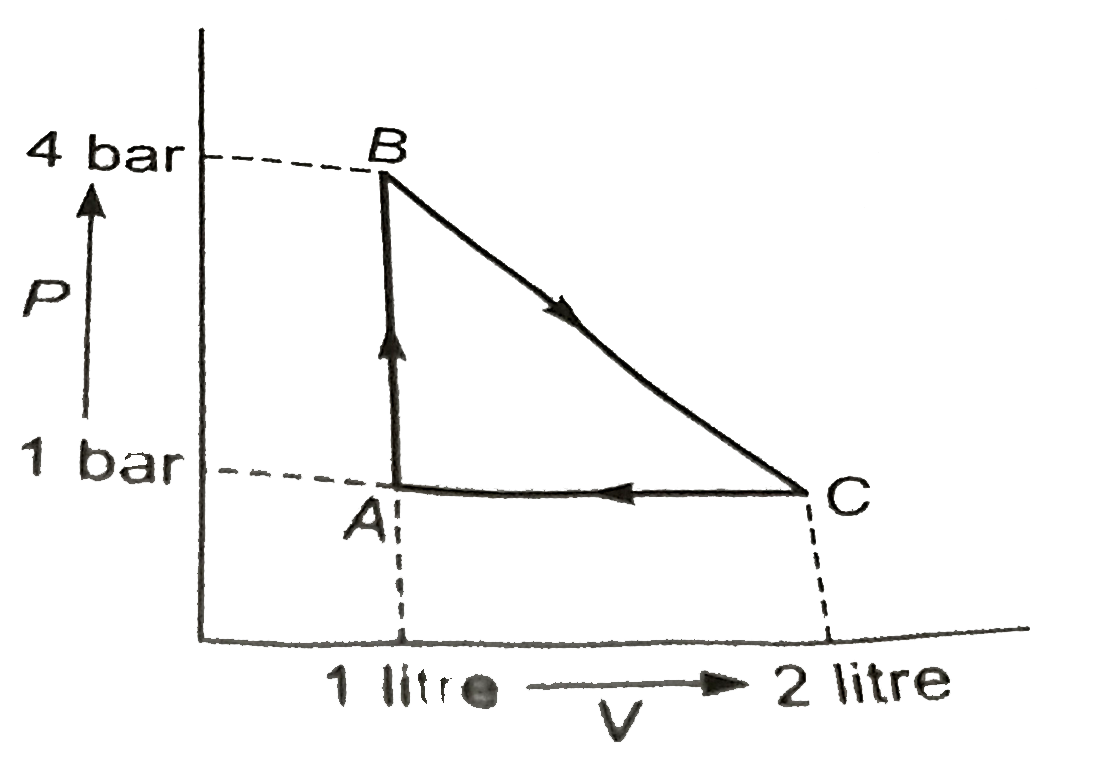
View SolutionA gas `(C_(v.m) = (5)/(2)R)` behaving ideally is allowed to expand reversibly and adiabatically from `1` litre to `32` litre. Its initial temperature is `327^(@)C`. The molar enthalpy change (in `J//mol`) for the process is :
View SolutionFor polytropic process `PV^(n)` = constant, molar heat capacity `(C_(m))` of an ideal gas is given by:
View Solution2 mole of an ideal monoatomic gas undergoes a reversible process for which `PV^(2)=C`. The gas is expanded from initial volume of 1 L to final volume of 3 L starting from initial temperature of 300 K. Find `DeltaH` for the process :
View SolutionThe enthalpy of neutralization of a Weak monoprotic acid (HA) in 1 M solution with a strong base is -55.95 KJ/mol . If the unionized acid required 1.4 KJ/mol heat for it's comptate ionzatation and enthalpy of netralization of the strong monobasic acid with a strong monoacidic base is -57.3 KJ/mol . What is the % ionzation of the weak acid in molar solution ?
View SolutionIf enthaopy of hydrogenation of `C_(6)H_(6)(l)` into `C_(6)H_(12)(l)` is `-205kJ//mol` and resonance energy of `C_(6)H_(6)(l)` is `-152kJ//mol` then enthaopy of hydrogenation of
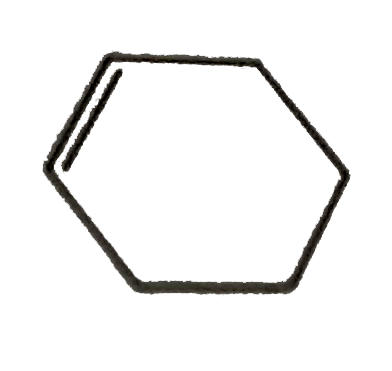
Assume `DeltaH_("vap")` of `C_(6)H_(6)(l),C_(6)H_(8)(l)` all equal :
View SolutionCalculate `DeltaS` for 3 mole of a diatomic ideal gas which is heated and compressed from 298 K and 1 bar to 596 K and 4 bar: [Given: `C_(v,m)(gas)=(5)/(2)R,"ln"(2)=0.70,R=2"cal K^(-1)mol^(-1)`]
View SolutionOne mole of an ideal monoatomic gas at `27^(@)C` is subjected to a reversible isoentropic compression until the temperature reached to `327^(@)C`. If the initial pressure was `1.0 atm`, then find the value of in `P_(2)`
`(` Given `: ln 2=0.7)`
View SolutionFor a perfectly crystalline solid `C_(p,m)=aT^(3)+bT`, where a and b are constant. If `C_(p,m)` is `0.40` J/K mol at 10 K and `0.92` J/K mol at 20 K, then molar entropy at 20 K is :
View SolutionCalculate `Delta_(r)G^(@)` for `(NH_(4)Cl,s)` at 310K.
Given :`Delta_(r)H^(@)(NH_(4)Cl,s)` =-314 kj/mol,`Delta_(r)C_(p)=0`
`S_(N_(2)(g))^(@)=192 JK^(-1mol^(-1)),S_(H_(2)(g))^(@)=130.5JK^(-1)mol^(-1),`
`S_(Cl_(2)(g))^(@)=233JK mol^(-1), S_(NH_(4)Cl(s))^(@)=99.5JK^(-1)mol^(-1)`
All given data at 300K
View SolutionCalculate `Delta_(f)H^(@)` (in kJ/mol) for `Cr_(2)O_(3)` from the `Delta_(r)G^(@)` and the `S^(@)` values provided at `27^(@)`
`4Cr(s)+3O_(2)(g)rarr2Cr_(2)O_(3)(s)," "Delta_(r)G^(@)=-2093.4kJ//mol`
`S^(@)("J//K mol") : S^(@)(Cr,s)=24," "S^(@)(O_(2),g)=205," "S^(@)(Cr_(2)O_(3),s)=81`
View SolutionThe value of `DeltaH_("transition")` of C (graphite) `rarr` C (diamond) is 1.9 kJ/mol at `25^(@)C`. Entropy of graphite is higher than entropy of diamond. This implies that :
View SolutionSelect the correct statements:
View SolutionSelect the correct statements:
View SolutionWhich are not correct representation at equilibrium :
View SolutionWhich of the following statements is/are correct
View SolutionPredict in which of the following, entropy increases:
View SolutionThe vapour pressure of solid benzoic acid has been found to obey the relationship ( in the neighbourhood of 298 K) as: `ln.(P)/(P^(@)) = a-(b)/(T)`, where a = 22.88 and `b = 1.07 xx 10^(4)K` Which of the following values are correct at 298 K for the sublimation of benzoic acid?
View SolutionSelect the incorrect statements about the plots of ln K vs 1/T
View SolutionA 250 W electric heater raised the temperature of a calorimeter by `4.22^(@)C` in 55s. When the oxidation of a methanol sample was carried out in the same calorimeter, the temperature rose from `22.49^(@)C` to `26.77^(@)C`. Then
View SolutionChoose the correct statements:
View Solution200g of water is contained in a beaker of mass 150 f at `20^(@)C`. The temperature of water is required to be raised to `80^(@)C`. It is given that the specific heat of water is `4.184 J//(g^(@)C)` and of glass is `0.78J//(g^(@)C)`. Then
View SolutionWhich one is not correct for a cyclic process as shown in the figure ?
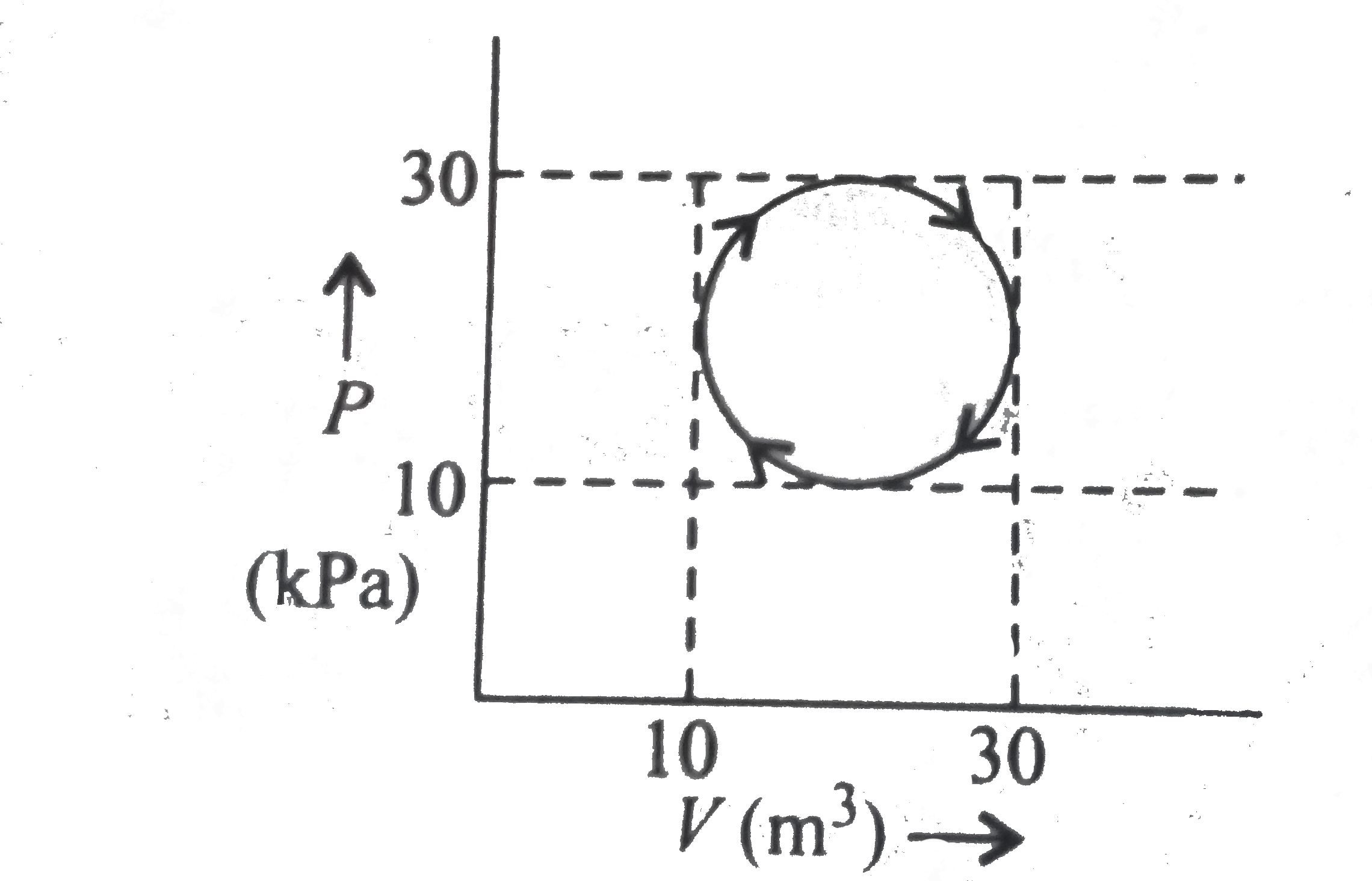
View SolutionSelect the incorrect statements for the equillibrium under standard condition:
`H_(2)O_((s))hArrH_(2)O_((l)), DeltaS_(1)^(@)`
`H_(2)O_((l))hArrH_(2)O_((v)), DeltaS_(2)^(@)`
`H_(2)O_((s))hArrH_(2)O_((v)), DeltaS_(3)^(@)`
View SolutionGiven, `2Fe_2O_(3(s)) to 4Fe_((s)) + 3 O_(2(g)), Delta_r G_1^@ = +1487kJmol^(-1)`
`6CO_((g)) +3O_(2(g)) to 6CO_(2(g)), Delta_r G_2^@ = -1543.2kJmol^(-1)` Select the correct statements:
View SolutionWhich of the following is correct for the change shown below ?
`underset(298K)(aA+bB) overset(Delta_(r)S_(1)^(@))rarrcunderset(298)(C+dD)`
`Delta_(r)S_(1)^(@)darr " " uarr Delta_(r)S_(4)^(@)`
`underset(0K)(aA+bB) overset(Delta S_(3)^(@))rarr cunderset(0K)(C+dD)`
View SolutionWhich of the following graphs given below show (s) adiabatic process?
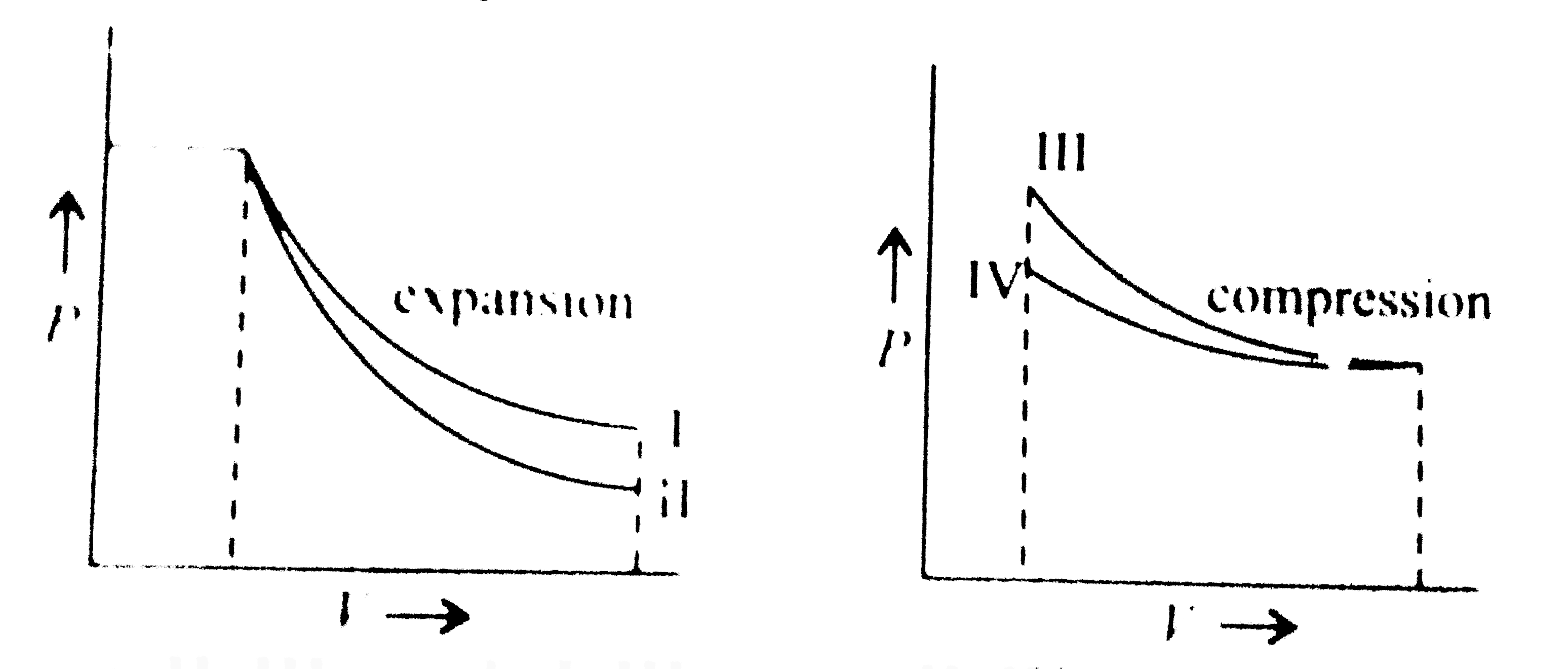
View Solution`He,N_(2)`, and `O_(3)` are expanded adiabatically and their expansion curves between `P` and `V` are plotted under silimar conditions. About the ratio of the slope, which one is not correct?
View SolutionHeat of neutralisation of strong acid and strong base under `1 atm` and `25^@C` is `-13.7 kcal`. If standard Gibbs energy change for dissociation of water to `H^+` and `OH^-` is `-19.14 kcal`, the change in standard entropy for dissociation of water is:
View SolutionOne mole of `CH_(3)COOH` undergo dimerization in vapour state at `127^(@)C` as `2CH_(3)COOH (g) hArr (CH_(3)COOH)_(2)` if dimer formation is due to two H-bonds involved in dimer, each of 33kJ strenght and the degree of dimerization of acetic acid `98.2%` which is correct
View SolutionWork done in expansion of an idela gas from `4L` to `6L` against a constant external pressure of `2.5 atm` was used to heat up `1mol` of water at `293K`. If specific heat of water is `4.184J g^(-1)K^(-1)`, what is the final temperature of water.
View SolutionWhat work is to be done on `2mol` of a perfect gas at `27^(@)C` it is compressed reversibly and isothermally from a pressure of `1.01 xx 10^(5) Nm^(-2) to 5.05 xx 10^(6)Nm^(-2)`?
View SolutionIf one mole of an ideal gas with `C_(v) = (3)/(2) R` is heated at a constant pressure of 1 atm `25^(@)C` to `100^(@)C`. Which is correct
View Solution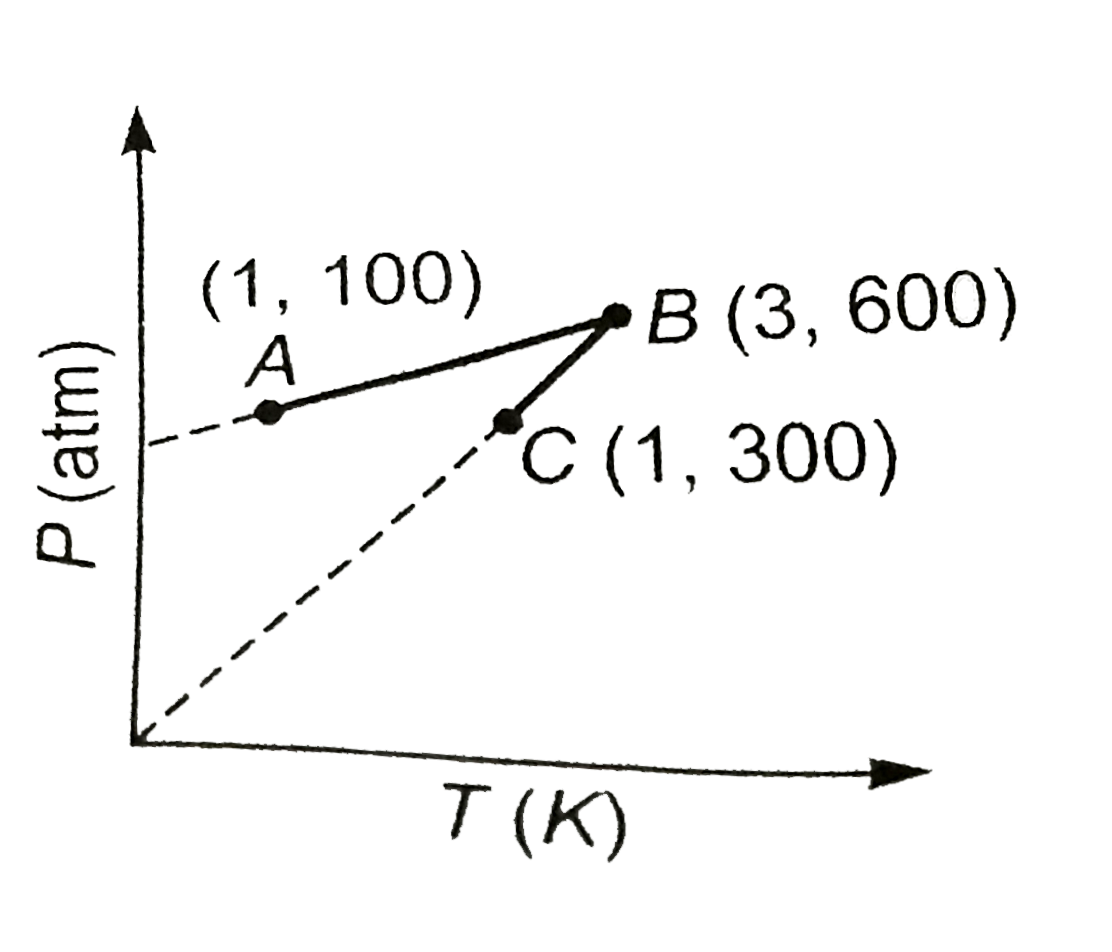
One mole of an ideal gas is subjected to a two step reversible process (A-B and B-C). The pressure at A and C is same. Mark the correct statement(s) :
View SolutionThe normal boiling point of a liquid X is 400 K. Which of the following statement is true about the process `X(l) to X(g)` ?
View SolutionFrom the following data, mark the option (s) where `Delta H` is correctlt written for the given reaction. Given
`H^(+)(aq) + OH^(-)(aq) rarr H_(2)O(l), Delta H = -57.3 kJ`
`Delta H_("solution")` of HA(g) = -70.7kJ/mol
`Delta H_("solution")` of BOH(g) = 20kJ/mol
`Delta H_("ionization")` of HA = 15 kJ/mol and BOH is a strong base Reaction `Delta H_(r)(kJ//mol)`
View SolutionThe bond dissociation energy of a diatomic molecule is also called bond energy. However, the bond dissociation energy depends upon the nature of bond and also the molecule in which the bond is present. The bond energy N-H bind in `NH_(3)` is equal to one-third of the energy of dissociation of `NH_(3)` because there are three N-H bonds and those of C-H bond in `CH_(4)` is equal to one-fourth of the energy of dissociation of `CH_(4)` Heat of a reaction = Bond energy of reactants - Bond energy of products
The enthalpy changes for the reaction `H_(2)O(g) rarr H(g)+OH(g)` and `OH (g) rarr O(g)+H(g)` are `501.87 kJ mol^(-1)` and `423.3 kJ mol^(-1)`. The bond enthalpy of O-H bond is
View SolutionThe bond dissociation energy of a diatomic molecule is also called bond energy. However, the bond dissociation energy depends upon the nature of bond and also the molecule in which the bond is present. The bond energy N-H bind in `NH_(3)` is equal to one-third of the energy of dissociation of `NH_(3)` because there are three N-H bonds and those of C-H bond in `CH_(4)` is equal to one-fourth of the energy of dissociation of `CH_(4)` Heat of a reaction = Bond energy of reactants - Bond energy of products
In which of the following, the bond enthalpy and bond dissociation enthalpy are identical ?
View SolutionThe bond dissociation energy of a diatomic molecule is also called bond energy. However, the bond dissociation energy depends upon the nature of bond and also the molecule in which the bond is present. The bond energy N-H bind in `NH_(3)` is equal to one-third of the energy of dissociation of `NH_(3)` because there are three N-H bonds and those of C-H bond in `CH_(4)` is equal to one-fourth of the energy of dissociation of `CH_(4)` Heat of a reaction = Bond energy of reactants - Bond energy of products
Find the bond enthalpy of S-S bond from the following data.
`C_(2)H_(5)-S-C_(2)H_(5)(g) " " Delta H_(f)^(@) = -147.23 kJ mol^(-1)`
`C_(2)H_(5)-S-S-C_(2)H_(5)(g) " " Delta H_(f)^(@) = -201.92 kJ mol^(-1)`
`S(g) Delta H_(f)^(@) = 222.80 kJmol^(-1)`
View SolutionThe first law thermodynamics was gives as `q=Delta U+(-w)`, where q is heat given to a system and `Delta U` represent increase in internal energy and -w is work done by the system. Various process such as isothermal, adiabatic, cyclic, isobaric and isochoric process in terms to first law of thermodynamics leads for important results. The molar heat capacity for 1 mole of monoatomic gas is 3/2R at constant volume and 5/2R at constant pressure.
Which of the following statements are correct:
View SolutionThe first law thermodynamics was gives as `q=Delta U+(-w)`, where q is heat given to a system and `Delta U` represent increase in internal energy and -w is work done by the system. Various process such as isothermal, adiabatic, cyclic, isobaric and isochoric process in terms to first law of thermodynamics leads for important results. The molar heat capacity for 1 mole of monoatomic gas is 3/2R at constant volume and 5/2R at constant pressure.
A system is allowed to move from state A to B following path ACB by absorbing 80 J of heat energy. The work done by the system is 30 J. The work done by the system in reaching state B from A is 10 J through path ADB which statements are correct :
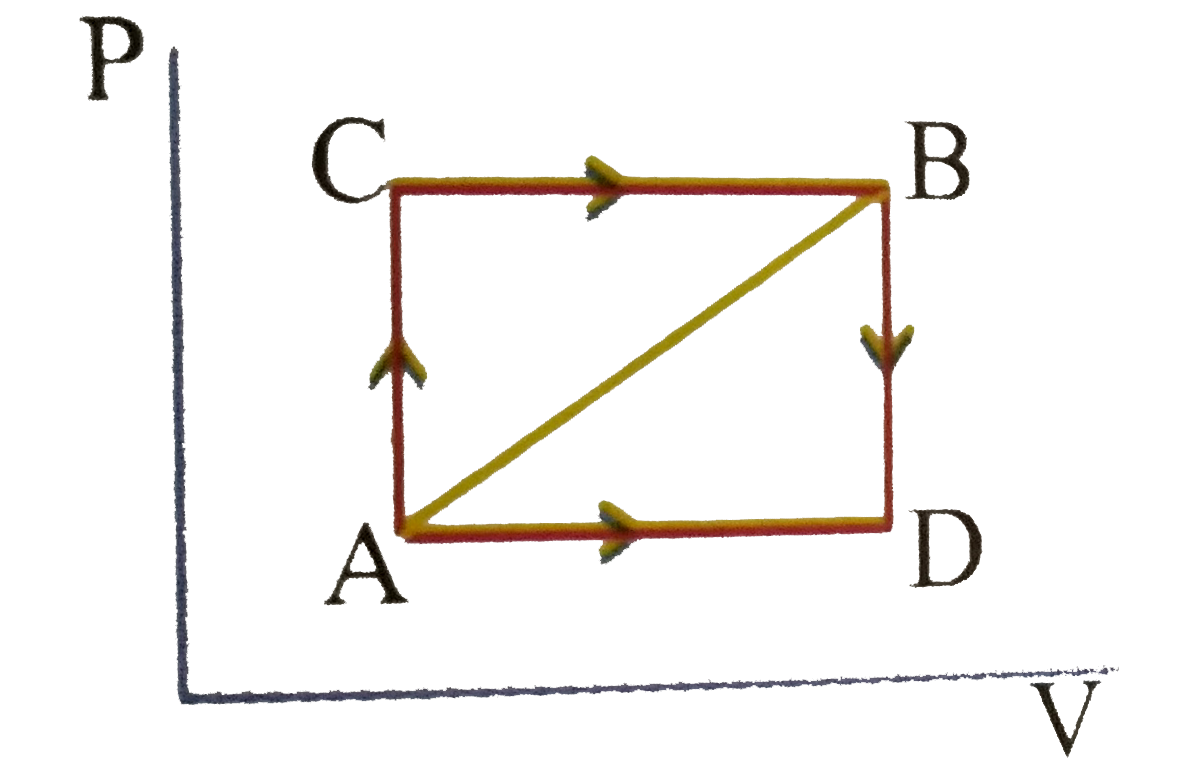
1. Increase in internal energy from state A to state B is 50 J.
2. If path ADB is followed to reach state B. `Delta U = 50J`
3. If work done by the system in path AB is 20 J, the heat absorbed during path AB = 70 J.
4. The value `U_(C)-U_(A)` is equal to `U_(D)-U_(B)`.
5. Heat absorbed by the system to reach B from A through path ADB is 60 J.
View SolutionThe first law of thermodynamics was given as `q=DeltaU+(-w)`, where `q` is heat given to a system and `DeltaU` represents increase in internal energy and `-w` is work done by the system. Various processes such as isothermal, adiabatic, cyclic, isobaric and isochoric process in terms of `I` law of thermodynamics leads for important results. The molar heat capacity for `1` mole of monoatomic gas is `3/2 R` at constant volume and `5/2 R` at constant pressure.
`1` mole of a monoatomic gas is expanded through path `ABC` as shown in figure:
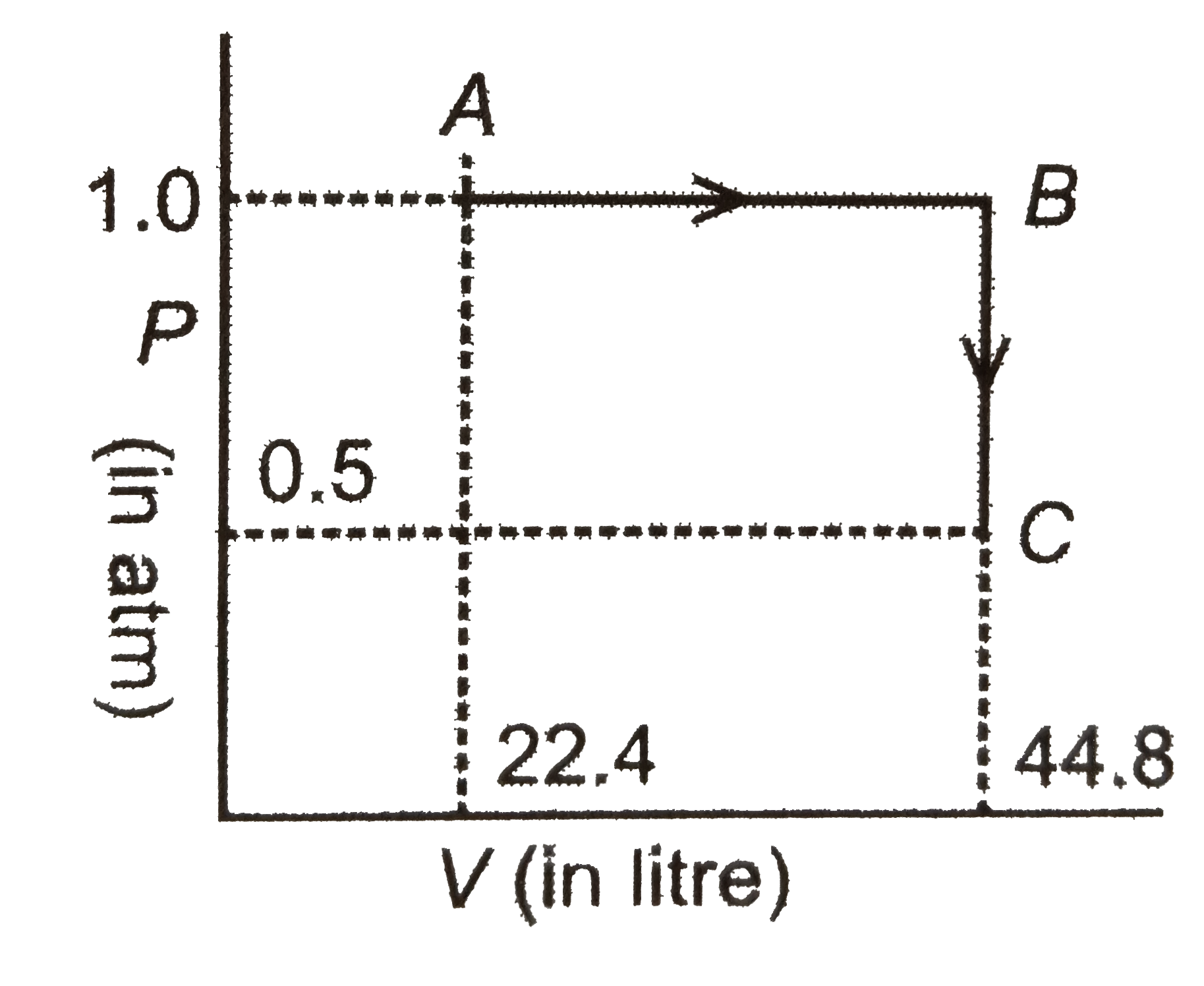 select the correct statements:
select the correct statements:
View SolutionEnthalpy of neutralzation is defined as the enthalpy change when 1 mole of acid`/ /`base is completely neutralized by base `//`acid in dilute solution .
For Strong acid and strong base neutralization net chemical change is
`H^(+) (aq)+OH^(-)(aq)to H_(2)O(l)`
`Delta_(r)H^(@)=-55.84KJ//mol`
`DeltaH_("ionization")^(@)` of aqueous solution of strong acid and strong base is zero .
when a dilute solution of weak acid or base is neutralized, the enthalpy of neutralization is somewhat less because of the absorption of heat in the ionzation of the because of the absorotion of heat in the ionization of the weak acid or base ,for weak acid /base
`DeltaH_("neutrlzation")^(@)=DeltaH_("ionization")^(@)+ Delta _(r)H^(@)(H^(+)+OH^(-)to H_(2)O)`
If enthalpy of neutralization of `CH_(3)COOH` by NaOH is -49.86KJ`//`mol then enthalpy of ionization of `CH_(3)COOH` is:
View SolutionEnthalpy of neutralzation is defined as the enthalpy change when 1 mole of acid /base is completely neutralized by base `//`acid in dilute solution .
For Strong acid and strong base neutralization net chemical change is
`H^(+) (aq)+OH^(-)(aq)to H_(2)O(l)`
`Delta_(r)H^(@)=-55.84KJ//mol`
`DeltaH_("ionization")^(@)` of aqueous solution of strong acid and strong base is zero .
when a dilute solution of weak acid or base is neutralized, the enthalpy of neutralization is somewhat less because of the absorption of heat in the ionzation of the because of the absorotion of heat in the ionization of the weak acid or base ,for weak acid /base
`DeltaH_("neutrlzation")^(@)=DeltaH_("ionization")^(@)+ Delta _(r)H^(@)(H^(+)+OH^(-)to H_(2)O)`
What is `DeltaH^(@)` for complate neutralization of strong diacidic base `A(OH)_(2)by HNO_(3)`?
View SolutionEnthalpy of neutralzation is defined as the enthalpy change when 1 mole of acid `//`base is completely neutralized by base `//`acid in dilute solution .
For Strong acid and strong base neutralization net chemical change is
`H^(+) (aq)+OH^(-)(aq)to H_(2)O(l)`
`Delta_(r)H^(@)=-55.84KJ//mol`
`DeltaH_("ionization")^(@)` of aqueous solution of strong acid and strong base is zero .
when a dilute solution of weak acid or base is neutralized, the enthalpy of neutralization is somewhat less because of the absorption of heat in the ionzation of the because of the absorotion of heat in the ionization of the weak acid or base ,for weak acid /base
`DeltaH_("neutrlzation")^(@)=DeltaH_("ionization")^(@)+ Delta _(r)H^(@)(H^(+)+OH^(-)to H_(2)O)`
under same conditions ,how many mL of 0.1 m NaOH and 0.05 M `H_(2)A` (strong diprotic acid ) solution should be mixed for a total volume of 100mL to producce the hight rise in temperature ?
View SolutionWork done by the system in isothermal reversible process is `w_(rev.)= -2.303 nRT "log"(V_(2))/(V_(1))`. Also in case of adiabatic reversible process work done by the system is given by: `w_(rev.) = (nR)/(gamma -1) [T_2 - T_1]`. During expansion disorder increases and the increase in disorder is expressed in terms of change in entropy `DeltaS = q_(rev.)/T`. The entropy changes also occurs during transformation of one state to other end expressed as `DeltaS = DeltaH/T`. Both entropy and enthalpy changes obtained for a process were taken as a measure of spontaniety of process but finally it was recommended that decrease in free energy is responsible for spontaniety and `DeltaG=DeltaH - T DeltaS`.
Which statements are correct? (1) The expansion work for a gas into a vacuum is equal to zero. (2) `1` mole of a gas occupying `3` litre volume on expanding to `15` litre at constant pressure of `1atm` does expansion work `1.215 kJ`. (3) The maximum work done during expansion of `16gO_2` at `300K` from `5dm^3` to `25 dm^3` is `2.01 kJ`. (4) The `DeltaS` for `S to L` is almost negligible in comparision to `DeltaS` for `L to G`. (5) `DeltaS = 2.303 nR "log"(V_(2))/(V_(1)).` (at constant `T`)
View SolutionWork done by the system in isothermal reversible process is `w_(rev.)= -2.303 nRT "log"(V_(2))/(V_(1))`. Also in case of adiabatic reversible process work done by the system is given by: `w_(rev.) = (nR)/(gamma -1) [T_2 - T_1]`. During expansion disorder increases and the increase in disorder is expressed in terms of change in entropy `DeltaS = q_(rev.)/T`. The entropy changes also occurs during transformation of one state to other end expressed as `DeltaS = DeltaH/T`. Both entropy and enthalpy changes obtained for a process were taken as a measure of spontaniety of process but finally it was recommended that decrease in free energy is responsible for spontaniety and `DeltaG=DeltaH - T DeltaS`.
The heat of vaporisation and heat of fusion of `H_2O` are `540 cal//g` and `80 cal//g`. This ratio of `(DeltaS_(vap.))/(DeltaS_("fusion"))` for water is:
View SolutionWork done by the system in isothermal reversible process is `w_(rev.)= -2.303 nRT "log"(V_(2))/(V_(1))`. Also in case of adiabatic reversible process work done by the system is given by: `w_(rev.) = (nR)/(gamma -1) [T_2 - T_1]`. During expansion disorder increases and the increase in disorder is expressed in terms of change in entropy `DeltaS = q_(rev.)/T`. The entropy changes also occurs during transformation of one state to other end expressed as `DeltaS = DeltaH/T`. Both entropy and enthalpy changes obtained for a process were taken as a measure of spontaniety of process but finally it was recommended that decrease in free energy is responsible for spontaniety and `DeltaG=DeltaH - T DeltaS`.
`Ag_2O_((s)) to 2Ag_((s)) + 1/2 O_(2(g))` attains equilibrium at temperature…`K` is : (The `DeltaH` and `DeltaS` for the reaction are `30.5kJ mol^(-1)` and `66J mol^(-1) K^(-1)` )
View SolutionWork done by the system in isothermal reversible process is `w_(rev.)= -2.303 nRT "log"(V_(2))/(V_(1))`. Also in case of adiabatic reversible process work done by the system is given by: `w_(rev.) = (nR)/(gamma -1) [T_2 - T_1]`. During expansion disorder increases and the increase in disorder is expressed in terms of change in entropy `DeltaS = q_(rev.)/T`. The entropy changes also occurs during transformation of one state to other end expressed as `DeltaS = DeltaH/T`. Both entropy and enthalpy changes obtained for a process were taken as a measure of spontaniety of process but finally it was recommended that decrease in free energy is responsible for spontaniety and `DeltaG=DeltaH - T DeltaS`.
A chemical change will definitely be spontaneous if:
View SolutionMatch the following
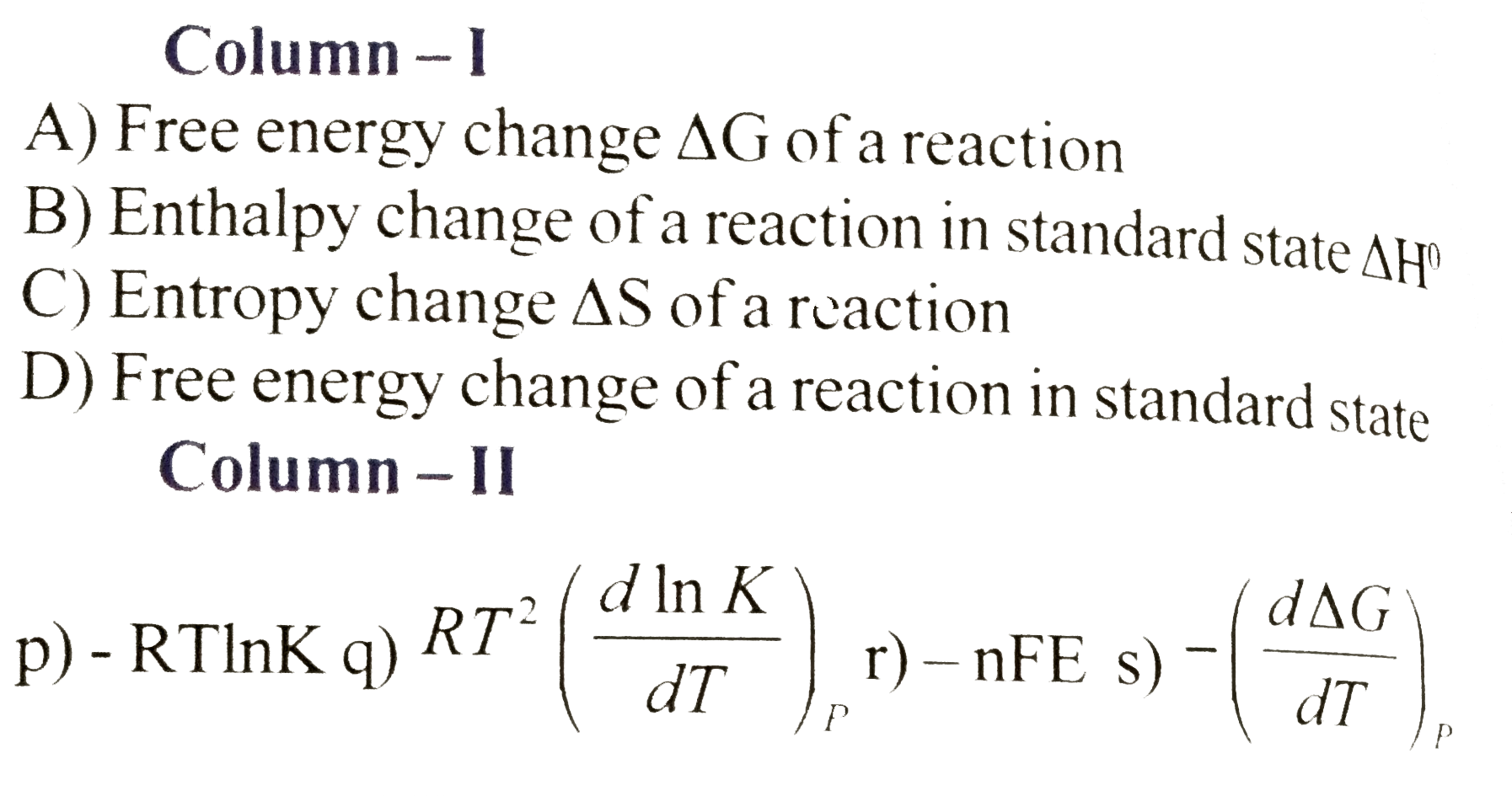
View SolutionMatch the following:
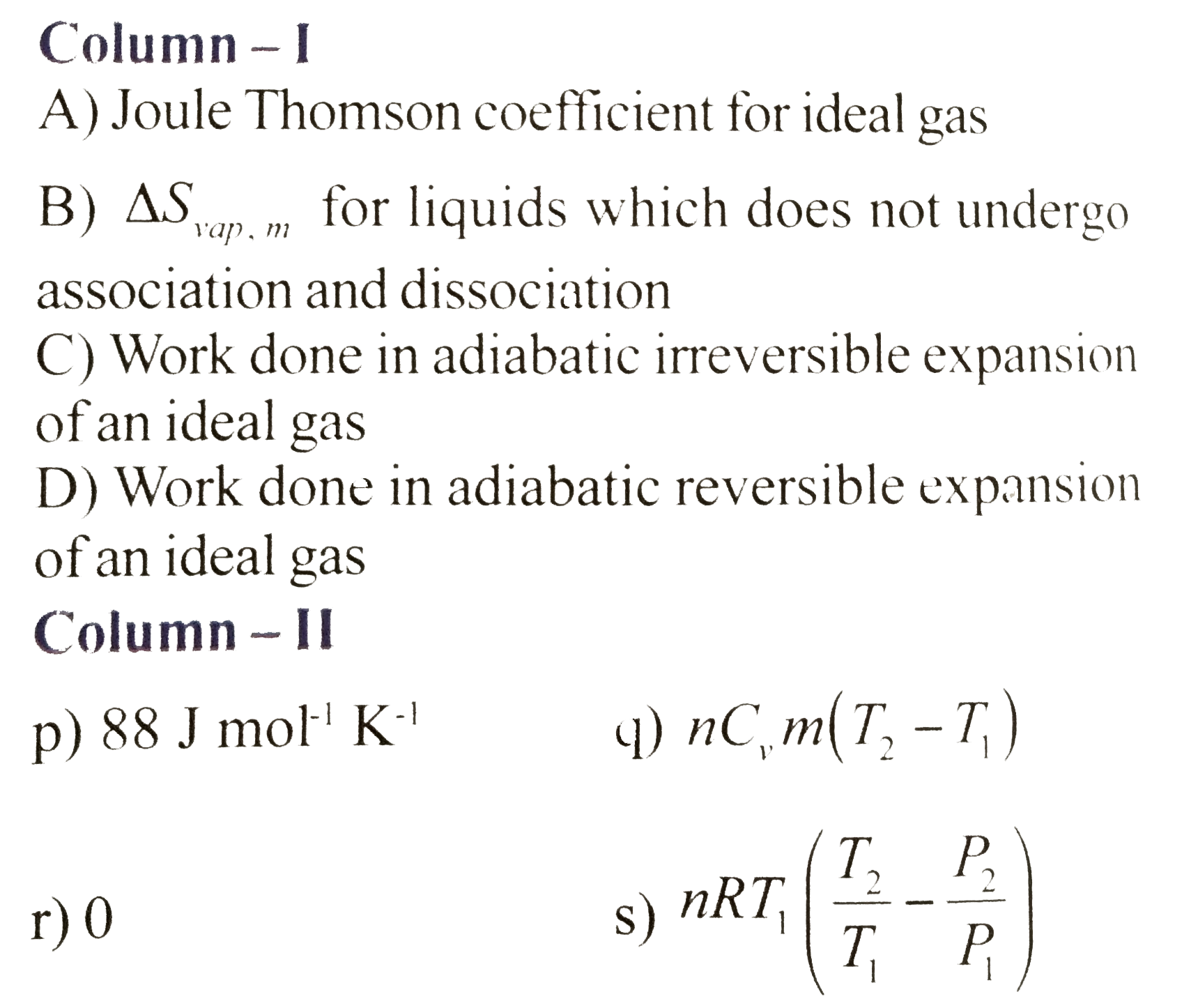
View SolutionMatch the following Columns
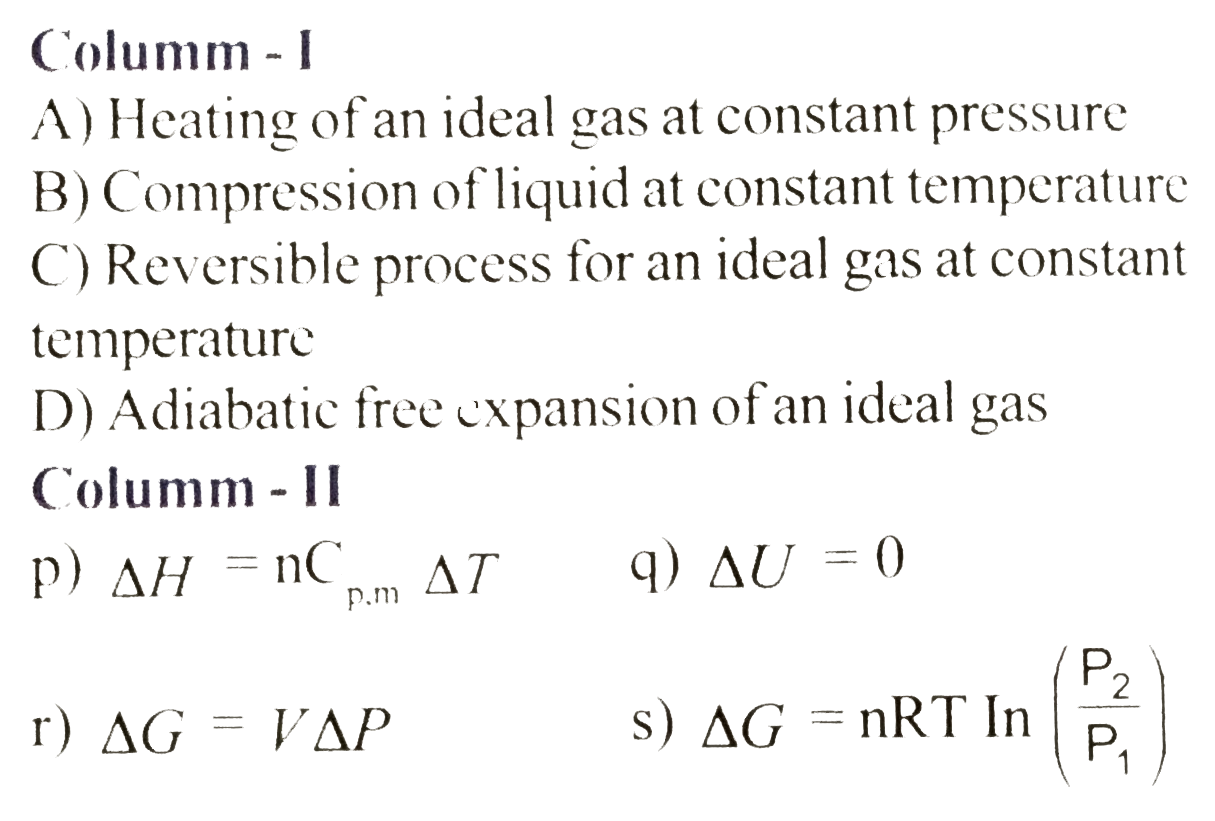
View SolutionMatch the following columns
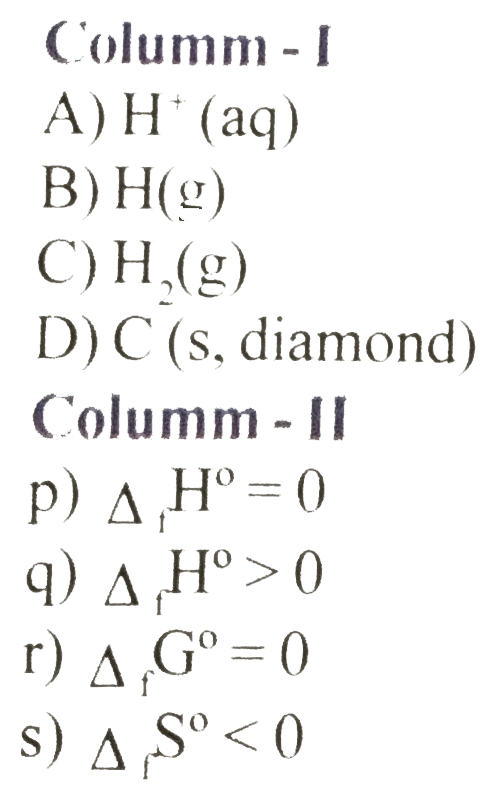
View SolutionMatch the following columns
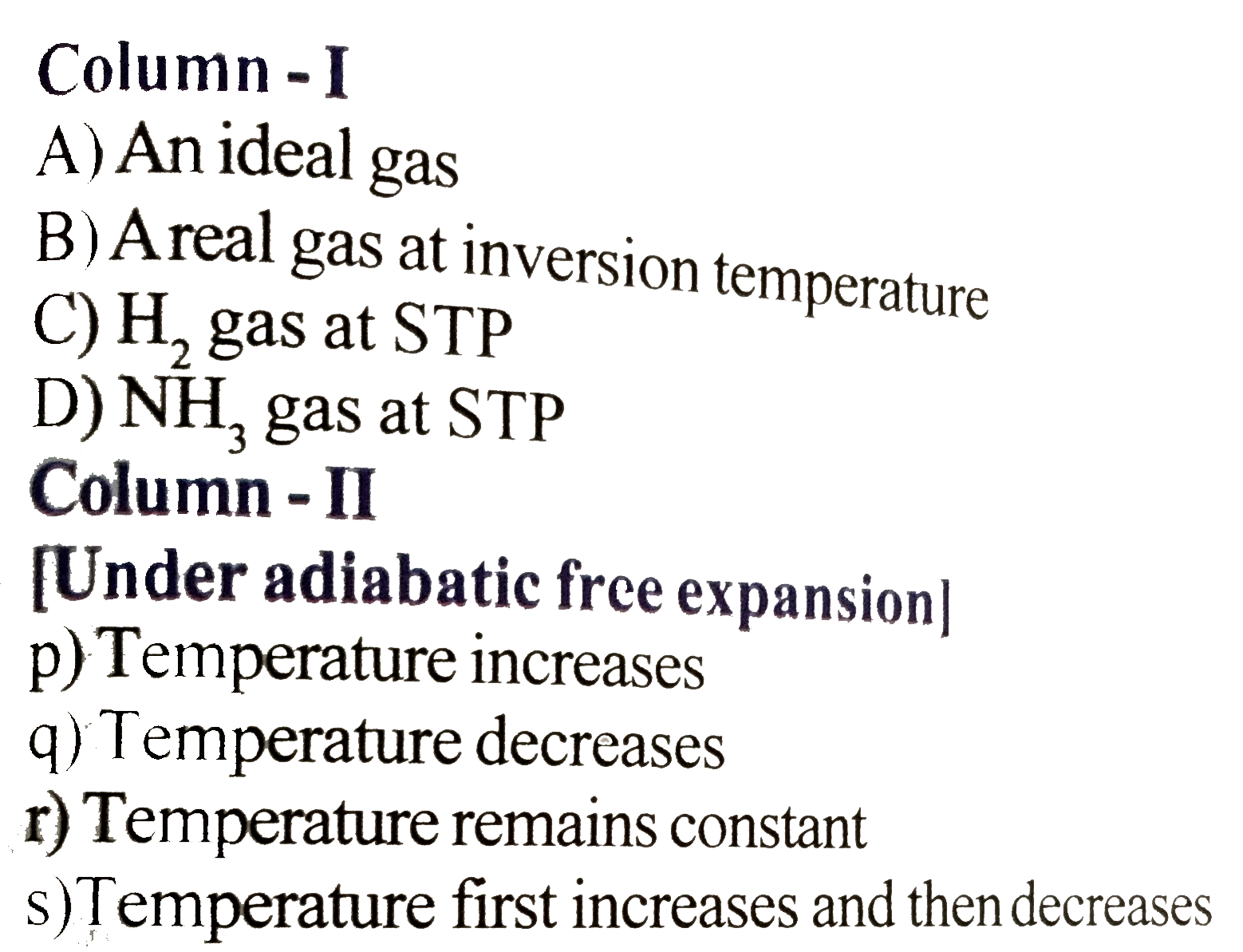
View SolutionThe feasibility of a chemical reaction can be explained based on DH, DS and DG, so an swer the following :
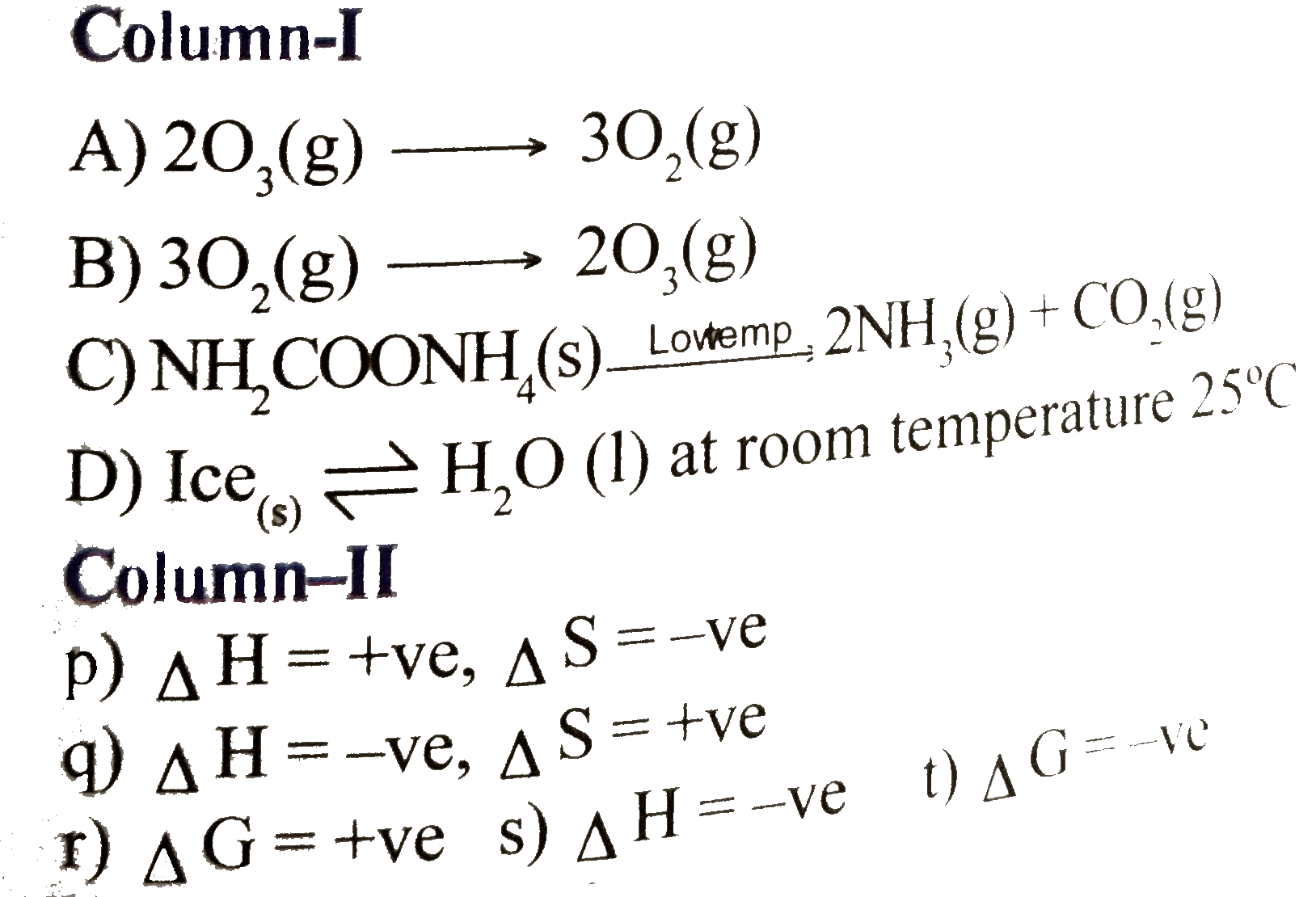
View SolutionMatch the following :
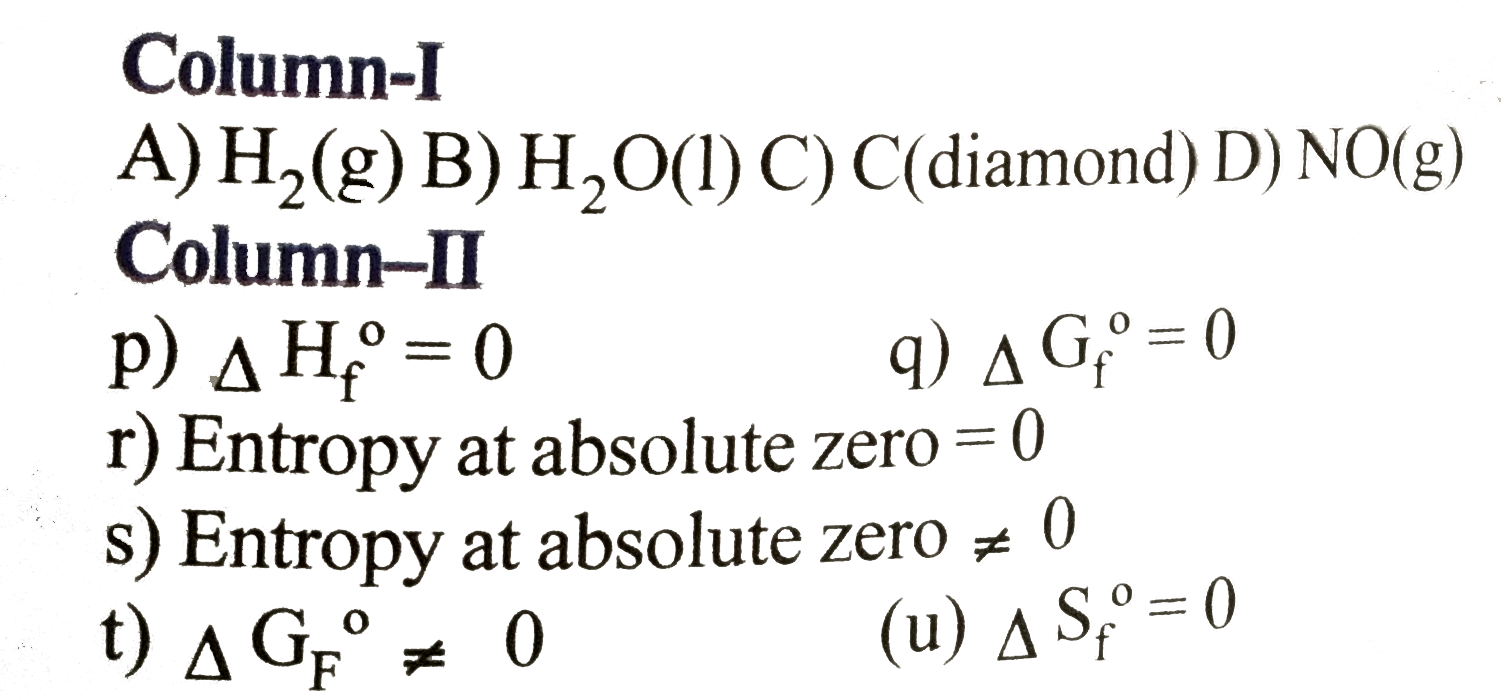
View SolutionStatement-1: For a process to be spontaneous, `Delta G` as well as `Delta S` has to be less than zero.
Statement-2 : For spontaneous change, `Delta S_("total") gt 0`
View SolutionAssertion:Phase transition involves change in internal energy only.
Reason:Phase transition occurs at constant pressure.
View SolutionStatement-1 : The work done in an open container at 300 K, when 112 g of iron reacts with dil. `HCl` is 200 cal.
statement-2 : Work done `= P_(ext)(V_(2)-V_(1))`, where `V_(1)` and `V_(2)` are initial and final volume of reaction mixture & `P_(ext)` is external applied pressure.
View SolutionStatement-1 : Many endothermic reactions that are not spontaneous at room temperature become spontaneous at high temperatures.
Statement-2: Energy of the system increases with increase in temperature.
View SolutionStatement: In the case of an ideal gas the changes in Gibbs and Helmholtz free energies are equal to each other (`DeltaG=DeltaA`) for isothermal reversible process.
Explanation: There is no change in internal energies and enthalpies for ideal gas at constant temperature.
View SolutionSTATEMENT-1 : The Heat absorbed during the isothermal expansionof an ideal gas against vacuum is zero.
STATEMENT-2 : The volume occupied by the molecules of an ideal gas is zero.
View SolutionEach question contains STATEMENT-1 (Assertion) and STATEMENT-2( Reason).
Examine the statements carefully and mark the correct answer according to the instruction given below:
STATEMENT-1: For a reaction at equilibrium, the Gibb's free energy of reaction is minimum at constant temp. and pressure.
STATEMENT-2: The Gibb's free energy of both reactants and products increases and become equal at equilibrium.
View SolutionAssertion: `C_(P)-C_(V)=R` for an ideal gas.
Reason: `((delE)/(delV))_(T)=0` for an ideal gas.
View SolutionStatement-1 : The amount of heat change during the isothermal free expansion of an ideal gas is zero.
Statement-2: There are no intermolecular forces of attraction among the gas molecules, in case of real gas at given pressure.
View SolutionStatement-1: The enthalpy of formation of H_(2)O(l)is greater than of H_(2)O(g) in magnitude.
Statement -2: Enthalpy chnge Is negative for the condensation reaction
`H_(2)O(g)toH_(2)O(l)`
View SolutionStatement-1: Heat of neutralisation of `H_(3)PO_(4)` with NaOH is more than that of HCl with NaOH.
Statement-2: `H_(3)PO_(4)` is a triprotic acid and hence release more heat on complete neutralization, while HCl is a monoprotic acid.
View SolutionStatement-1 : Work done in isothermal reversible process is more than irreversible process.
And
Statement-2 : Irreversible process is an infinitesimally slow process.
View SolutionStaetement -1: The magniyude of the work involed in an isothermal expansion is greater than that involved in an adiabatic expansion.
Statement -2: P-v cure (pon y -axas and V on X-axas) decrease more repidly for reversible asiabatic expansion compared to reversible isothermal expansion starting from same initial state.
View SolutionStatement -1: For every chmical reaction at equilibrium , standard Gidds energy of reaction is zero
Statement-2: At constant temperature and pressure , chemical reactions are spontaneious in the direction of decreasing gibbs energy.
View SolutionStatement-1: There is a natural asymmetry between work to heat and converting heat to work .
Statement-2: No process is possible in which the sole result is the absorption of heat from a reservoir and its complaete conversion into work .
View SolutionStatement -1: Entropy change in reversible adiabatic expansion of an ideal gas is zero.
Statement-2: The increase in entropy due to volume increase just compensates the decrease in entropy due to fall in temperature.
View SolutionStatement -1: The Standard free energy changes of all spontaneously occurring reactions are negative .
Statement-2: The standard free energies of the elements in their standard states at 1 bar and 2985K aare taken aszero.
View SolutionStatement -1: Enthalpy and entropy of any elements substance in the standard states are taken as zero .
Statement-2: At absolute zero , partiles of the perfectly crystalline substance become completely motioness.
View SolutionStatement-1: A reaction which is spontaneous and accompained by decrease of randomness must be exothermic.
Statement -2: All exothermic reaction that are accomained by decrease of randomness.
View SolutionStatement -1: Many endothermic reactions that are not spontaneous at room temperature become spontaneous at high temperature.
Statement-2: `DeltaH^(@)` of the endothermic recation increases with increases with increase in temperature.
View SolutionStatement-1: Decrease of free energy during the process under constant temperature and pressure provides a measure of its spontaneity.
Statement -2: A spontaneous change must have +ve sign of `DeltaS_("system").`
View SolutionStatement-1: All combustion reactions are exothermic.
Statement-2: Enthalpies of products greater than enthalpies of reactants `(Sv_(p)D_(f)H(P) gt Sv_(R)D_(f)(R))`
View SolutionStatement-1: Due to adiabatic free expansion temperature of real gas may increase.
Statement-2 : In adiabatic free expansion, temperature is always constant irrespective of real or ideal gas
View SolutionStatement-1: Under adiabatic free expansion, `((dU)/(dV))_(T)` is +ve when attractive forces are dominant between gas molecules [U,V,T respectively]
Statement-2: Internal energy is a state function.
View SolutionStatement-1: At low temperatures, DH is the dominant factor for spontaneity of a reaction.
Statement-2: At low temperatures, the opposing factor TDS remains very small.
View SolutionStatement-1: A reaction which is spontaneous and accompained by decrease of randomness must be exothermic.
Statement -2: All exothermic reaction that are accomained by decrease of randomness.
View Solution
Level -V questions and complete solutions for chapter THERMODYNAMICS of NARAYANA CHEMISTRY (HINGLISH) of Class 11